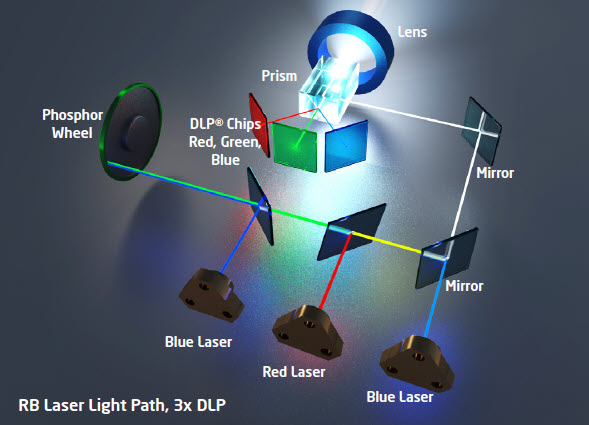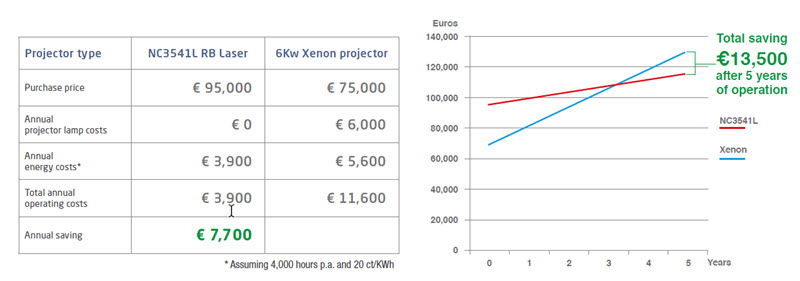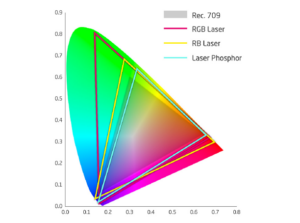Sometimes, it’s interesting to see how the same challenges come up for different display technologies, and despite the differences between the core technologies, similar ways of achieving the same effect are used. Getting a good colour gamut is one of those challenges.

Often the challenge in getting a wider colour gamut is to achieve primary RGB colours that are more pure and less diluted by colours that are away from the pure colours at the extremes of the colour triangles.
In LCDs, you can use separate LEDs for red, green and blue in the backlight, but that causes a lot of problems in getting consistent results over time and over a range of conditions because of the variation in the driving needed for the different colours of LED (always a big challenge in LEDs). Another way to avoid the variability is to use blue LEDs and convert to red and green using quantum dots and that is being used in LCDs in TVs and in monitors. However, it is not a cheap solution.
We’ve talked about how those looking to provide a wider colour gamut in monitors and TVs have tried to improve the colour gamuts of LCDs that are illuminated by white LEDs, using yellow YAG phosphors, which is the cheapest way to backlight the LCD. A problem with the yellow produced is that it is very impure, so it’s hard to get the pure primaries need for WCG. Ideally, as when you use RGB LEDs, is to use separate sources, but that is challenging.
The other way to get a wider gamut is to filter the light to take out the frequencies between the red and green, an approach that is followed in LCDs by LG with its Nano-Cell technology. (Palomaki and Bertram Uncover LG’s “Nano Cell” Secret). Another way is to change the phosphors used to individual red and green rather than the mixed yellow. (There’s More than One Way to Make a WCG LCD).
Projection Challenges
Projection faces challenges too. There is no question that the widest colour gamuts can be created using laser projection – in fact, at the moment, the only way to make a projector that meets the full Rec 2020 colour gamut is to use red, green and blue lasers. Lasers, of course, emit very pure light in terms of frequency. But lasers are expensive and green lasers, in particular have been very difficult to develop with good efficiency. So, one way to get round this is to follow a similar approach to that used in LCD backlights and use phosphor to convert blue light to yellow and that is how most laser phosphor projectors work – with a blue laser and a yellow phosphor wheel.
As with backlights, some makers are using special filters to chop out some of the light between red and green to achieve purer primaries and wider gamuts. However, filtering out light is never a good idea if you want the highest possible efficiency.
Adding to the mix in-between ‘pure lasers’ and the volume laser phosphor market, which is rapidly driving lamp-based projection to only be sold at the lowest priced entry level, is another approach. We recently got an update from NEC on its RB laser technology which is being used in very bright (up to 35,000 Ansi lumens) projectors as an intermediate method.

The RB laser system, as the name suggests, uses Red and Blue lasers, while relying on phosphor to convert blue for the green – which means a relatively pure green can be created and without the challenges of having to use a green laser.
Of course, this kind of projector competes with projectors using Xenon lamps. However, over a five year lifetime, NEC believes that the bigger outlay for the RB technology is paid back and we have replicated the data it presented below.

Of course, there are few truly unique optical solutions, so others have similar approaches – Christie has what it calls BoldColor and we think this is behind the Digital Projection Colour Boost technology. (BR)

